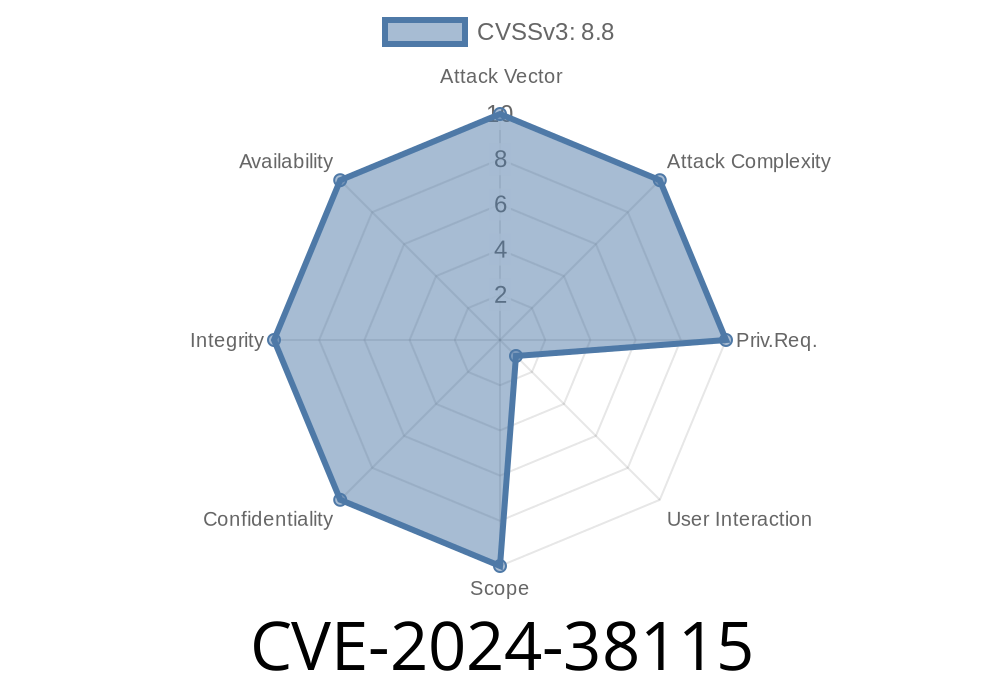---
Windows keeps evolving, but so do the vulnerabilities aimed at its core management tools. One of the latest in 2024 is CVE-2024-38115, a security hole lurking in a tool unsuspecting admins might use every day: the Windows IP Routing Management Snap-in. Let’s break down what this is, how it can be exploited, and what you can do to stay safe.
What Is CVE-2024-38115?
CVE-2024-38115 is a Remote Code Execution (RCE) vulnerability in the Windows IP Routing Management MMC Snap-in (rrasmgmt.msc). The bug lets attackers run malicious code on your system just by tricking you into opening a specially crafted file or connecting to a dangerous network setup. In plain language: attackers can take over your machine—likely with the same rights as you.
How Does The Attack Work?
This vulnerability centers around how the snap-in parses data—especially when loading routing configuration files or connecting to remote servers. If the snap-in encounters an unexpected payload, it can mishandle memory or execute embedded script code. Here’s the typical flow:
Admin or user loads the file into IP Routing Management (via MMC).
3. Malware gets executed in the context of the logged-in user, often SYSTEM if run as administrator.
This is especially dangerous if the attacker crafts a lure—maybe a fake “routing configuration update” or an email phishing campaign targeting network administrators.
Code Snippet: Example of a Malicious Config
A real-world proof of concept is not public (yet), but here’s a simplified demonstration in PowerShell to simulate dropping a malicious script via a file:
# Simulated PowerShell code for payload execution
$payload = '[System.Diagnostics.Process]::Start("calc.exe")'
Set-Content -Path "C:\Temp\maliciousRoute.cfg" -Value $payload
# When the snap-in parses this crafted file, it could execute the payload
If an exploit is completely weaponized, the attacker might wrap this payload in the file format used by the snap-in, so that opening the config would silently run malicious code.
References for Original Details
- Microsoft’s advisory: https://msrc.microsoft.com/update-guide/vulnerability/CVE-2024-38115
- NIST National Vulnerability Database: https://nvd.nist.gov/vuln/detail/CVE-2024-38115
- (Optional, for advanced readers) Snap-in documentation: https://learn.microsoft.com/en-us/windows-server/networking/technologies/rras/rras-top
Proof of Concept and Real-World Impact
Currently, a public exploit isn’t in the wild, but security researchers predict that it’s only a matter of time. The flaw is similar to previous remote code execution bugs in MMC snap-ins, which often result in silent privilege escalation or system compromise.
Example Exploit Scenario
1. Attacker sends an email to sysadmins: "Urgent: Route configuration update – please import ASAP to resolve connectivity issues."
2. The attached file (crafted using knowledge of CVE-2024-38115) gets opened in IP Routing Management snap-in.
Monitor for abnormal activity within your networks, especially involving management tools.
5. Implement application whitelisting and EDR (Endpoint Detection and Response) for early detection.
Conclusion
CVE-2024-38115 is a perfect illustration of how even everyday admin tools can become dangerous attack surfaces in Windows. If you use Routing and Remote Access, be extra vigilant about file imports, network connections, and patching. Attackers don’t always need to break down the front door—sometimes it’s as easy as loading the wrong config file.
Stay current. Stay sharp. Patch your systems.
Got more questions? Reach out via Microsoft Security Response Center or discuss on forums like Reddit r/sysadmin.
Timeline
Published on: 08/13/2024 18:15:12 UTC
Last modified on: 08/24/2024 00:06:19 UTC
